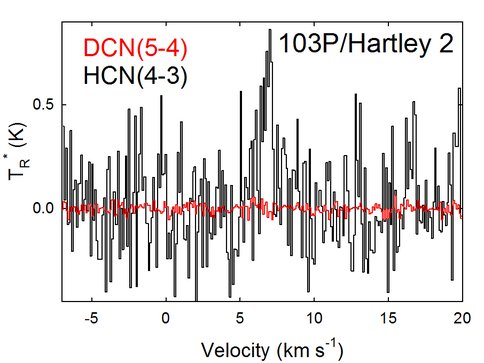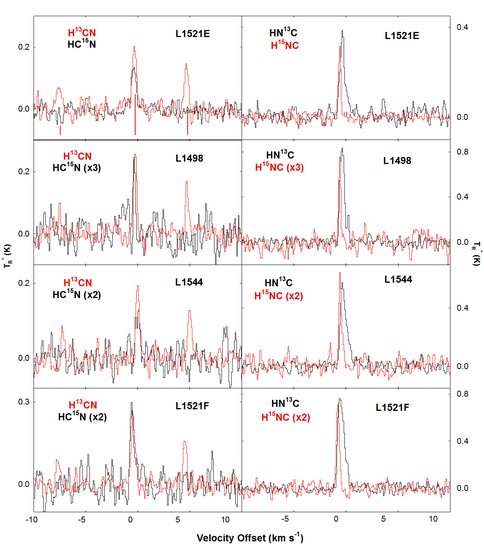2011 Annual Science Report
 NASA Goddard Space Flight Center
Reporting | SEP 2010 – AUG 2011
NASA Goddard Space Flight Center
Reporting | SEP 2010 – AUG 2011
Radio Observations of Simple Organics: Tracing the Origins and Preservation of Solar System Materials
Project Summary
We have continued observational programs designed to explore the chemical composition of comets and establishing their potential for delivering pre-biotic organic materials and water to the young Earth and other planets. State of the art, international facilities are being employed to conduct multiwavelength, simultaneous, studies of comets in order to gain more accurate abundances, distributions, temperatures, and other physical parameters of various cometary species. Additionally, observational programs designed to test current theories of the origins of isotopically fractionated meteorite (and cometary) materials are currently underway. Recent chemical models have suggested that in the cold dense cores of star forming regions, significant isotope enrichment can occur for nitrogen and possibly vary between molecular species and trace an object’s chemical evolution. Observations are being conducted at millimeter and submillimeter wavelengths of HCN and HNC isotopologues for comparison to other nitrogen-bearing species to measure fractionation in cold star forming regions.
Project Progress
Theme I Progress: We have continued observational programs designed to explore the chemical composition of comets and establishing their potential for delivering pre-biotic organic materials and water to the young Earth and other planets. State of the art, international facilities are being employed to conduct multiwavelength, simultaneous, studies of comets in order to gain more accurate abundances, distributions, temperatures, and other physical parameters of various cometary species. This effort is accomplished with collaborations from the National Radio Astronomy Observatory (A. Remijan), the Joint Astronomy Center (I. Coulson), ASIAA (group of Prof. Y-J. Kuan), Observatoire de Paris (D. Bockelee-Morvan & N. Biver), and Caltech (M. Drahaus) utilizing the Arizona Radio Observatory’s 12m and Submillimeter Telescopes, the JCMT, NRAO GBT 100m, Herschel Space Observatory, ALMA, and the Onsala Space Observatory.
Data from two cometary appartions in 2010 are currently being analyzed and prepared for publication. Comet C/2009 R1 (McNaught), a long-period comet, came a mere 0.4 AU from Earth in June 2010. The Jupiter family comet 103P/Hartley 2, approached < 0.1AU from Earth, was the rendezvous target for NASA’s Deep Impact Extended Investigation (the DIXI component of the EPOXI space mission), was observed, collectively, from 12 October 2010 to 5 November 2010. Preliminary results of McNaught suggest a normal organic abundance with respect to H2O. The molecular abundances in these two objects will be compared to those observed in other comets, supporting a long-term effort of building a comet taxonomy based on composition. Previous work (Mumma et al. 2003; DiSanti & Mumma 2008) has revealed a range of abundances of parent species (from “organics-poor” to “organics-rich”) with respect to water among comets, however the statistics are still poorly constrained and interpretations of the observed compositional diversity are uncertain. Additionally, other cosmogonic quantities, such as the ortho:para ratio and isotope ratios, were measured to probe the origin of these cometary organics. Analysis of these data is currently underway. For Hartley 2, we obtained a D/H ratio of >0.01, from HCN isotopologues, which will help constrain the origin of this particular species in cometary bodies since the interstellar DCN/HCN value is 0.1-0.01 (Roueff & Gerin 2002), Figure 1. Results from both of these apparitions have been presented at the 2010 DPS Meeting, Pacifichem 2010, IAU Astrochemistry Symposium 280: The Molecular Universe, and the 42nd LPSC.
Figure 1. HCN was monitored daily to confirm ephemeris accuracy, and monitor the jet activity and periodicity (~18 hrs) of the coma. Significant upper limits were obtained for DCN, yielding D/H < 0.01, consistent with other cometary values. This value suggests a non-interstellar origin for this species.
This year, we have targeted three apparitions including 45P/Honda-Mrkos-Pajdusakova, C/2010 X1 (Elenin), and C/2009 P1 (Garradd). 45P is a JFC that reached only 0.06AU from Earth. Sadly, this close encounter did not produce the anticipated molecular flux, though a few detections were made and have been published (Coulson et al. 2011, IAU Circ, 9237). Comet C/2010 X1 (Elenin), a new dynamical object, was predicted to be quite active due to its close approach (Δ~0.25AU) and estimated magnitude of 5. However, this comet seemed to dissipate into a “diffuse smudge” around 27 August, while the closest approach was anticipate for mid October (Mattiazzo 2011). We attempted to observe this object in early September, with no success of molecular detections at radio wavelengths. Recently, observations have been conducted towards comet C/2009 P1 (Garradd), verifying significant activity at large heliocentric distances. This has provoked a long term monitoring campaign for this target at multiple facilities including the JCMT, ARO 12m and SMT, GBT, and in collaboration with high resolution infrared measurements being conducted by Mumma, DiSanti, Villanueva, and Bonev.
Additionally, a workshop on comet taxonomy was held in Annapolis, MD on 13-16 March 2011. This workshop brought together experts on cometary observations presenting the latest results on the chemical composition of comets, the taxonomic classifications that are emerging at different observational wavelengths, and their relevance to the origin and evolution of the Solar System. The success of this workshop has led to preparations for a follow-up meeting in the winter of 2012.
Theme II Progress: Isotopologues provide important tests of processes and models pertaining to the origin and evolution of organics in Planetary Systems. A significant theoretical effort has been made to understand how low-temperature chemistry, either in the outer regions of nebula or in the presolar dense core, could fractionate organic molecules, and to so identify possible observational and experimental signatures (Charnley & Rodgers 2008, 2009; Rodgers & Charnley 2008).
Observational programs designed to test current theories of the origins of isotopically fractionated meteorite (and cometary) materials are currently underway. It is thought, in some cases, to trace interstellar material that was incorporated into the solar system without undergoing significant processing. Recent chemical models have suggested that in the cold dense cores of star forming regions, significant isotope enrichment can occur for nitrogen and possibly vary between molecular species and trace an object’s chemical evolution.
Observations are being conducted at millimeter and submillimeter wavelengths of HCN and HNC isotopologues, employing various facilities in order to both spatially and spectrally, resolve emission from these cores. The preliminary data was collected at the Arizona Radio Observatory’s 12m telescope on Kitt Peak, AZ, Figure 2. Spectra were obtained at high resolution (0.08 km/s) in order to resolve dynamic properties of each source as well as to resolve hyperfine structure present in certain isotopologues. Most of the previous work on nitrogen and carbon isotopes in dense cores has applied a double isotope method to their analysis to overcome large opacity effects, requiring assumptions for one of the isotopes as either a measurement of a different species known to trace different regions (i.e. 12CO and 13CO) or using the local ISM values. These methodologies may provide false abundances for various species and can introduce errors to further analysis and applications to chemical models. Thus, we are directly measuring all isotopologues for a given species and employ a direct analytical method for determining abundances and thus the true isotope ratios. Preliminary data suggest significant fractionation in the nitrile species compared to other N-bearing molecules towards the same objects, see Table 1. Further observations of higher transitions with the Arizona Radio Observatory’s Submillimeter telescope are currently underway to further constrain each species abundance and thus isotope ratio.
Figure 2. Arizona Radio Observatory spectra of the J=1→0 lines of HCN and HNC 13C and 15N isotopologues in four dark cloud cores. These types of inclusive observations of molecular families and their isotopologues will provide an accurate assessment of fractionation in dense cores.
Table 1.
In regards to the origins of primitive materials, a workshop at the Lorentz Center in Leiden, NL has been organized for 5-9 December 2011. A major goal of this meeting to ascertain which of the molecular isotopic signatures found in primitive Solar System matter are indicative of pristine interstellar molecules. Scientists from different communities will be brought together to present the state-of-the-art knowledge in their respective areas of expertise.
Isotopes in Astrochemistry, 5 – 9 December 2011, Lorentz Center, Leiden University
GCA also co-sponsored an International Workshop on Isotopes in Astrochemistry (5-9 December 2011, Lorentz Center, Leiden University), with 50 invited participants. Scientific Organizers were Drs. Steven Charnley and Stefanie Milam (GCA Team), Conel Alexander (CIW Team), and Prof. Ewine vanDishoeck (Leiden University). The aim of the workshop was to obtain a clearer picture of the fate of observed interstellar isotopic fractionation patterns as they were incorporated into the protosolar nebula. A major goal was to ascertain which of the molecular isotopic signatures found in primitive Solar System matter are indicative of pristine interstellar molecules. The workshop assembled scientists from different communities to present the state-of-the-art knowledge in their respective areas of expertise, and also provided a forum for younger scientists wishing to become acquainted with the big picture. Timely insights on isotopic ratios in many key interstellar molecules were addressed, as provided by Herschel for the ISM and for comets, and by laboratory analyses of returned samples of cometary dust (Stardust) and related samples of carbonaceous chondritic meteorites. Future insights from Herschel and ALMA, as well as, in the longer term, from Rosetta and a comet sample return mission were also addressed.
Publications
-
Cordiner, M. A., Charnley, S. B., Buckle, J. V., Walsh, C., & Millar, T. J. (2011). DISCOVERY OF INTERSTELLAR ANIONS IN CEPHEUS AND AURIGA. The Astrophysical Journal, 730(2), L18. doi:10.1088/2041-8205/730/2/l18
-
Cordiner, M. A., Cox, N. L. J., Evans, C. J., Trundle, C., Smith, K. T., Sarre, P. J., & Gordon, K. D. (2010). A SURVEY OF DIFFUSE INTERSTELLAR BANDS IN THE ANDROMEDA GALAXY: OPTICAL SPECTROSCOPY OF M31 OB STARS. The Astrophysical Journal, 726(1), 39. doi:10.1088/0004-637x/726/1/39
-
Meech, K. J., A’Hearn, M. F., Adams, J. A., Bacci, P., Bai, J., Barrera, L., … Ziffer, J. E. (2011). EPOXI : COMET 103P/HARTLEY 2 OBSERVATIONS FROM A WORLDWIDE CAMPAIGN. The Astrophysical Journal, 734(1), L1. doi:10.1088/2041-8205/734/1/l1
-
Nuevo, M., Milam, S. N., Sandford, S. A., De Gregorio, B. T., Cody, G. D., & Kilcoyne, A. L. D. (2011). XANES analysis of organic residues produced from the UV irradiation of astrophysical ice analogs. Advances in Space Research, 48(6), 1126–1135. doi:10.1016/j.asr.2011.05.020
-
Wirström, E. S., Geppert, W. D., Hjalmarson, Å., Persson, C. M., Black, J. H., Bergman, P., … Vigren, E. (2011). Observational tests of interstellar methanol formation. A&A, 533, A24. doi:10.1051/0004-6361/201116525
-
PROJECT INVESTIGATORS:
-
PROJECT MEMBERS:
Stefanie Milam
Co-Investigator
-
RELATED OBJECTIVES:
Objective 2.2
Outer Solar System exploration
Objective 3.1
Sources of prebiotic materials and catalysts
Objective 3.2
Origins and evolution of functional biomolecules
Objective 7.1
Biosignatures to be sought in Solar System materials


